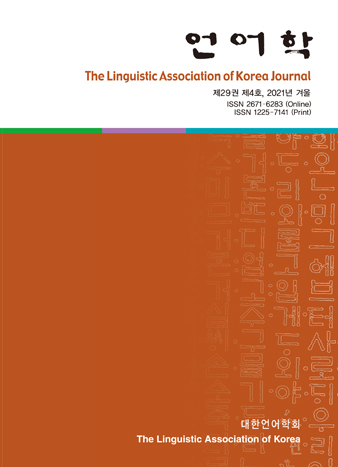대한언어학회 전자저널
29권 4호 (2021년 12월)
- Subjectless as-parenthetical Constructions in English: A Corpus-based Approach
-
Seulkee Park & Jong-Bok Kim
Pages : 93-112
Abstract
Park, Seulkee & Kim, Jong-Bok. (2021). Subjectless as-parenthetical constructions in English: A corpus-based approach. The Linguistic Association of Korea Journal, 29(4), 93-112. As-parenthetical constructions usually include either a sentential or predicate gap, but they can also have a subject gap. In this paper, we first investigate the authentic uses of subjectless as-parenthetical clauses, referring to the extracted corpus data. One of the key issues that emerges from the corpus data is that the subjectless as-clause is missing an expletive subject gap as well as a clausal complement gap. The subject gap is construed as a proposition containing a proper predicate for the antecedent. Our corpus findings show that the predicate type in subjectless as-clauses determines whether the expletive subject it is elided optionally or obligatorily. Based on the observed properties, we suggest that subjectless as-parenthetical constructions are base-generated rather than derived from deletion operations. Our corpus-based view can account for the idiosyncratic properties of subjectless as-parenthetical constructions in a streamlined manner.
Keywords
# as-parentheticals # subject ellipsis # expletive it # conventional implicature # question under discussion
References
- Dehe, N., & Kavalova, Y. (Eds.). (2007). Parentheticals. Amsterdam: John Benjamins Publishing Company.
- Flickinger, D. (2008). Transparent heads. In Proceedings of the 15th International Conference on Head-Driven Phrase Structure Grammar, 87-94.
- Grice, H. P. (1975). Logic and conversation. In P. Cole & J. L. Morgan (Eds.), Speech Acts (pp. 41-58). Leiden, The Netherlands: Brill.
- Huddleston, R., & Pullum, G. (2002). The Cambridge grammar of the English language. Cambridge: Cambridge University Press.
- LaCara, N. (2016). Evidence for deletion in as-parentheticals. The Linguistic Review, 33(4), 579-610.
- Lee-goldman, R. (2012). Supplemental relative clauses: Internal and external syntax. Journal of Linguistics, 48(3), 573-608.
- Postal, P. M. (2004). Skeptical linguistic essays. New York, NY: Oxford University Press.
- Potts, C. (2002a). The lexical semantics of parenthical-as and appositive- which. Syntax, 5(1), 55-88.
- Potts, C. (2002b). The syntax and semantics of as-parentheticals. Natural Language & Linguistic Theory, 20, 623-689.
- Potts, C. (2005). The logic of conventional implicatures. New York, NY: Oxford University Press.
- Prado-Alonso, C. (2015). The “as be the case” construction. English Studies, 96(6), 690-709.
- Quirk, R., Greenbaum, S., Leech, G., & Svartvik. J. (1985). A comprehensive grammar of the English language. London, GB: Longman.
- Seppänen, A, & Herriman. J. (2002). Extraposed subjects vs. postverbal complements: On the so-called obligatory extraposition. Studia Neophilologica, 74(1), 30-59.
- Simons, M. (2010). A Gricean view on intrusive implicatures. In K. Petrus (Ed.), Meaning and analysis: New essays on H. Paul Grice (pp. 138-169). London: Palgrave Macmillan.
